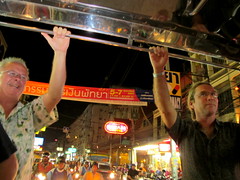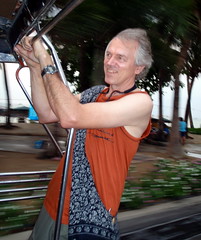Getting to places can appear overwhelmingly complicated when the language is different—and even more so when its written script is not even remotely familiar. But visitors do get around, so it is simply a matter of figuring out how everything works.
 In Thailand it seems totally chaotic at first. Small pickup trucks with welded tubular frames and sideways seating toot as they approach to indicate that they have room for you. In Pattaya, there was usually no indication of where these “bhat buses” were going, but we found that they made loops along popular routes: if we found ourselves turning away from our destination, we could push a buzzer button and hop off—paying the driver 10 bhat each (~30 cents).
In Thailand it seems totally chaotic at first. Small pickup trucks with welded tubular frames and sideways seating toot as they approach to indicate that they have room for you. In Pattaya, there was usually no indication of where these “bhat buses” were going, but we found that they made loops along popular routes: if we found ourselves turning away from our destination, we could push a buzzer button and hop off—paying the driver 10 bhat each (~30 cents).
 The bhat buses fill up as they make their way, and if you are brave, you can hang on to the looped tubing at the back and actually see things a lot better. The view from inside is limited—but while the outside view is great, the prospect of potential bodily harm if the driver has to make a sudden stop is rather daunting!
The bhat buses fill up as they make their way, and if you are brave, you can hang on to the looped tubing at the back and actually see things a lot better. The view from inside is limited—but while the outside view is great, the prospect of potential bodily harm if the driver has to make a sudden stop is rather daunting!
A map is a good thing to have, although most drivers have no idea how to read it even if it is bilingual, showing the Thai. We found that landmarks are best: with the name of a hotel or a shopping area, bhat bus drivers were good at getting us there (or at least close).
The “tuk tuks” we’ve been using in Chiang Mai are small motorized tricycles with fairly comfortable seats and a canopy top offering similarly limited views. They weave in and out of traffic with just finger-breadths to spare and seem only marginally safer than the ubiquitous motorbikes.
 On Saturday we needed to buy intercity bus tickets by going to the Arcade bus stop in Chiang Mai. Our destination would be Chiang Rai, and we’d been advised to book at minimum two days in advance to procure tickets because there are only 16 or so seats available on any day… We hired a tuk tuk to get us there: 140 baht. We liked our capable, fun driver whose name was Mr. Horse, so hired him for the rest of the day: the total for 5 hours was just 400 bhat (~$12)! Moreover, we hired Mr. Horse for the next two days: he safely transported us to Baan Tong Luang tribal village and to the Wat overlooking Chiang Mai.
On Saturday we needed to buy intercity bus tickets by going to the Arcade bus stop in Chiang Mai. Our destination would be Chiang Rai, and we’d been advised to book at minimum two days in advance to procure tickets because there are only 16 or so seats available on any day… We hired a tuk tuk to get us there: 140 baht. We liked our capable, fun driver whose name was Mr. Horse, so hired him for the rest of the day: the total for 5 hours was just 400 bhat (~$12)! Moreover, we hired Mr. Horse for the next two days: he safely transported us to Baan Tong Luang tribal village and to the Wat overlooking Chiang Mai.
It just goes to show that the real costs here are not labour, but fuel and capital.
The long-haul buses are a very reasonable way to get around too. We reserved two seats on an overnight bus from Pattaya to Chiang Mai for 725 bhat (~$22). It took 11 hours, was air conditioned (to the point we were glad to have the provided blankets!), and they served water, juice, and more snacks than we could eat. What was particularly interesting was that the driver and full-time assistant were in the front, completely closed off from the passengers. The immaculate attendant also put on the video for everyone to watch. Incidentally, this bus arrived in Chiang Mai 45 minutes ahead of schedule.
Getting around is much easier than it looks—and inexpensive methods are quite comfortable. Looking online first helps; as does having a decent map. Fortunately, the language issues are seldom a problem: just smile and ask and just like us, you’ll discover someone will always be there to help.
